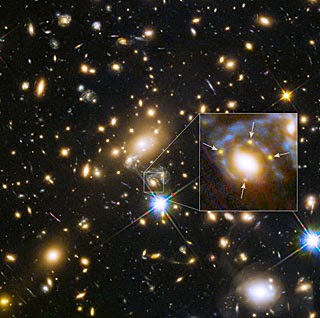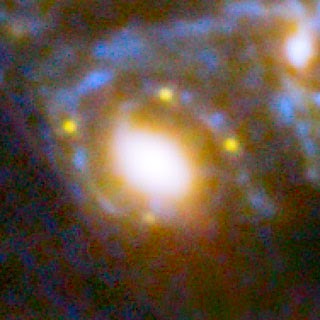| Online: | |
| Visits: | |
| Stories: |

| Story Views | |
| Now: | |
| Last Hour: | |
| Last 24 Hours: | |
| Total: | |
Einstein Cross in Never Before Seen Images of a Stellar Explosion
Whilst looking closely at a massive elliptical galaxy and its associated galaxy clusterMACS J1149+2223 — whose light took over 5 billion years to reach us— astronomers have spotted a strange and rare sight. The huge mass of the galaxy and the cluster is bending the light from a much more distant supernova behind them and creating four separate images of it. The light has been magnified and distorted due to gravitational lensing [1] and as a result the images are arranged around the elliptical galaxy in a formation known as an Einstein cross.
This image shows the huge galaxy cluster MACS J1149+2223, whose light took over 5 billion years to reach us. The huge mass of the cluster and one of the galaxies within it is bending the light from a supernova behind them and creating four separate images of it. The light has been magnified and distorted due to gravitational lensing and as a result the images are arranged around the elliptical galaxy in a formation known as an Einstein cross. A close-up of the Einstein cross is shown in the inset.
Credit: NASA, ESA, S. Rodney (John Hopkins University, USA) and the FrontierSN team; T. Treu (University of California Los Angeles, USA), P. Kelly (University of California Berkeley, USA) and the GLASS team; J. Lotz (STScI) and the Frontier Fields team; M. Postman (STScI) and the CLASH team; and Z. Levay (STScI)
This animation shows how the huge galaxy cluster MACS J1149+2223 — whose light took over 5 billion years to reach us — bends the light from a supernova lying behind the cluster so that Hubble captures four images of the supernova.
Credit: NASA, ESA, S. Rodney (John Hopkins University, USA) and the FrontierSN team; T. Treu (University of California Los Angeles, USA), P. Kelly (University of California Berkeley, USA) and the GLASS team; J. Lotz (STScI) and the Frontier Fields team; M. Postman (STScI) and the CLASH team; and Z. Levay (STScI)
“The supernova appears about 20 times brighter than its natural brightness,”explains the paper’s co-author Jens Hjorth from the Dark Cosmology Centre, Denmark. “This is due to the combined effects of two overlapping lenses. The massive galaxy cluster focuses the supernova light along at least three separate paths, and then when one of those light paths happens to be precisely aligned with a single elliptical galaxy within the cluster, a secondary lensing effect occurs.” The dark matter associated with the elliptical galaxy bends and refocuses the light into four more paths, generating the rare Einstein cross pattern the team observed.
This unique observation will help astronomers refine their estimates of the amount and distribution of dark matter in the lensing galaxy and cluster. There is more dark matter in the Universe than visible matter, but it is extremely elusive and is only known to exist via its gravitational effects on the visible Universe, so the lensing effects of a galaxy or galaxy cluster are a big clue to the amount of dark matter it contains.
This illustration shows how four different images of the same supernova were created when its light was distorted and magnified by the huge galaxy cluster MACS J1149+2223 in front of it. The light has been magnified and distorted due to gravitational lensing and as a result the images are arranged around the elliptical galaxy in a formation known as an Einstein cross.
The massive galaxy cluster focuses the supernova light along at least three separate paths, and then when one of those light paths happens to be precisely aligned with a single elliptical galaxy within the cluster, a secondary lensing effect occurs. The dark matter associated with the elliptical galaxy bends and refocuses the light into four more paths, generating the rare Einstein cross pattern that the team observed.

“The four supernova images captured by Hubble appeared within a few days or weeks of each other and we found them after they had appeared,” explains Steve Rodney of Johns Hopkins University, USA, leader of the Frontier Fields Supernova team. “But we think the supernova may have appeared in a single image some 20 years ago elsewhere in the cluster field, and, even more excitingly, it is expected to reappear once more in the next one to five years — and at that time we hope to catch it in action.”
The supernova has been nicknamed Refsdal in honor of Norwegian astronomer Sjur Refsdal, who, in 1964, first proposed using time-delayed images from a lensed supernova to study the expansion of the Universe. “Astronomers have been looking to find one ever since,” said Tommaso Treu of the University of California Los Angeles, USA, the GLASS project’s principal investigator. “And now the long wait is over!”
Georgia Bladon
ESA/Hubble
Source:





